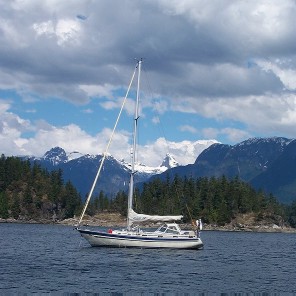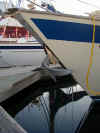S/V Cats Paw
This section is about S/V Cats Paw, her gear, and her equipment.
Why a Malö?
S/V Cats Paw is a 1998 Malö 42, built in Kungsviken, on the Isle of Orust, Sweden. This little island is a hotbed of Swedish boatbuilding, home to Hallberg-Rassy, Najad, and other builders, as well as Malö.

There are several features that drew us to her. First, is the extreme build quality. Even deep down in the bowels of the boat, you find the same consistent attention to detail.
Another feature is the "Targa Arch." This allows the traveler to be placed up off the deck, resulting in fewer pinched hands and snagged lines. It also allows a fully enclosed cockpit: the arch supports a canvas cover, which can be zipped up, making it nice and snug inside. Perfect for high-latitude cruising!
We have also found the company to be extremely responsive. They are just the right size: large enough that they are economically viable, yet not so large that you are forgotten among thousands of owners.
They are very stoutly built; perhaps overbuilt — Cats Paw weighs nearly 30,000 pounds. She carries a big rig, but that's still a lot of mass to get moving. On the other hand, she never pounds and tends to sit placidly at anchor.

But, the most important reason for chosing a Malö was the combination of a traditional look with a modern underbody and rig. We never liked the "Clorox bleach bottle" look that is so trendy nowadays. Malös have a much more traditional look with a nice shear line and a salty looking cabin!
Besides the Targa Arch, another signature feature of Malös is the way they ship the anchor through the stem of the boat. This is a bit more of a mixed bag. Advantages are that it cleans up the foredeck (I have to say I've never snagged a line on the anchor!), keeps the rode tension down low, and makes it impossible for the rode to jump off a roller in a wild storm. On the other hand, it makes it very difficult to work on the anchor or chain because of their location way down low near the waterline. It also makes it very difficult (though not impossible) to use the windlass on more than one rode. Score it a mixed blessing.
Shortly after we bought the boat, Malö stopped making the 42s, replacing them with the new (in 2001) Malö 43. They are nearly identical in length, beam, and draft, but there are subtle differences. The 43s are fuller and flatter in the stern, less full in the bow, and are considerably (5,500 lbs) lighter. I imagine they would be much better light-air boats, and more likely to surf in strong winds — nice features, but then mass also has its advantages. The 43s also have a flatter sheer (sniff! so much for my favorite feature!) and a slightly domed coachroof. But, at a distance, it is tough to tell them apart.

Oh, and one other thing about Malös: you sure learn how to type those funny ö's on a US keyboard!
England
We bought Cats Paw in March, 2001 in Poole, England after a memorable seatrial in the English Channel in true snotty spring conditions — 30 knots of winds, 30°F, and 6 foot chop. We were so bundled up, we looked like a crew of Michelin Men. Still, it was perfect conditions to bring the best out in the boat. It handled the steep chop of the Channel with aplomb, the decks nearly dry when we made it back to the slip. We were sold.
Buying a boat internationally is a bit weird. While the amounts involved may seem large to us, by international finance standards, they are nothing. It is very expensive to get an exchange rate guaranteed for these amounts, so you are forced to shovel a bunch of US dollars down a pipe and yell down "Is that enough?" If not, you just keep shoveling until the broker on the other end says "OK! That's it!" It took us three shovelfuls to get it right. Fortunately, it actually took less than we expected because the dollar was near an all time high at the time (April, 2001).
Shipping the boat from the UK to the US was straightforward, but involved a lot of hidden costs, such as building a cradle ($1280), UK terminal charges ($890), UK customs clearance charges ($20), forwarding fees (whatever that is, $237), US customs clearance charges ($849), customs agent ($810), Tacoma unloading ($898), and trucking to Seattle ($650). In addition, you may want to take out insurance and you may or may not pay someone to decommission the boat on the sending end, and recommission on the receiving end, depending on how handy you are. It's not cheap, but because of the favorable exchange rate, we still ended up paying less than for any comparable boat in the US.
Measurements
Every beauty contest needs a set of measurements. Here's Cats Paw's:
| LOA | 42.8' |
| LWL | 34.8' |
| I | 55.5' |
| J | 16.8' |
| P | 50.0' |
| E | 17.0' |
| SA | 1140 sq ft. |
| Beam | 13.1' |
| Draft | 6.4' |
| Displacement | 29,800lbs |
| Ballast | 12,130lbs |
| Bal/DISP | 41% |
| DISP/LWL | 315.7 |
| SA/DISP | 18.9 |
| Capsize ratio | 1.69 |
| PHRF rating | 86 |
She was built under Lloyd's Register Certification (certificate number GOT 9850081), and is Category 1 rated.
Projects
Because Cats Paw was a dealer "demo" boat, we were her first owners, even though she was nearly three years old at the time. While she came fairly well equipped for a "new" boat (especially in electronics), there was still a tremendous amount of work that had to be done to make her "cruise ready." Naturally, we dramatically underestimated the amount of time this would take us (although, fortunately, not the expense!).
Some of the many projects:
- Sailomat 601 self-steering windvane
- Icom 710RT single sideband
- Dinghy storage on deck
- Second fuel filter
- Engine-driven bilge pump
- Windscreen grab rails
- New battery box and batteries
- Fischer-Panda genset
- Foot operated freshwater pump
- Prosine 2.0 inverter/charger
- Asymmetrical spinnaker
- Deck wash system
Equipment
Go to our special equipment section.
